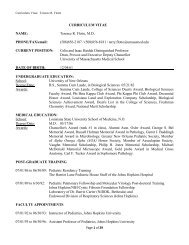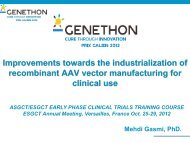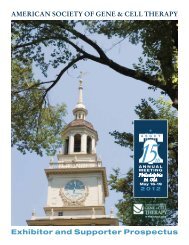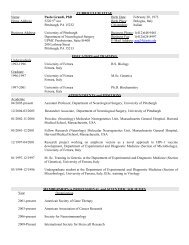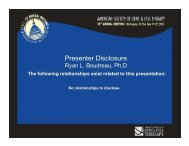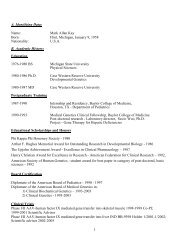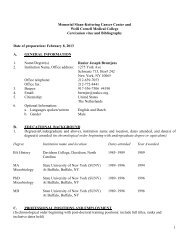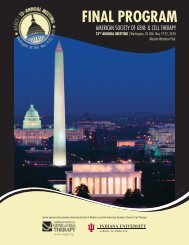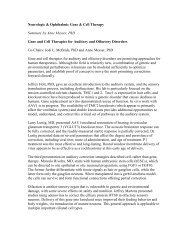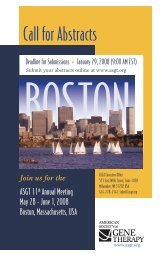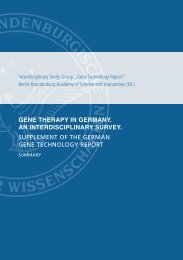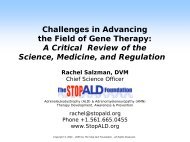Final Program - American Society of Gene & Cell Therapy
Final Program - American Society of Gene & Cell Therapy
Final Program - American Society of Gene & Cell Therapy
You also want an ePaper? Increase the reach of your titles
YUMPU automatically turns print PDFs into web optimized ePapers that Google loves.
<strong>Program</strong> Schedule, Friday, May 17, 2013<br />
Workshop 350<br />
7:30 pm - 9:30 pm<br />
ROOM: BALLROOM C<br />
International Consortium for <strong>Gene</strong> and <strong>Cell</strong> <strong>Therapy</strong> Workshop<br />
CHAIR: Jacques P. Tremblay, PhD<br />
SPEAKERS<br />
Jacques P. Tremblay, PhD<br />
Introduction to the Creation <strong>of</strong> an International Consortium <strong>of</strong> <strong>Gene</strong><br />
Dr. Tremblay has recently published in collaboration with 50 experts in gene therapy a letter in Molecular <strong>Therapy</strong> proposing<br />
the creation <strong>of</strong> an International Consortium <strong>of</strong> <strong>Gene</strong> <strong>Therapy</strong> to accelerate the development <strong>of</strong> clinical applications. Indeed the<br />
recent progress in genomics has permitted to identify the genes responsible for 10,000 hereditary monogenic diseases. Although<br />
each one <strong>of</strong> these diseases is rare (they are thus designated as orphan diseases), this whole group <strong>of</strong> diseases affects 8% <strong>of</strong> the<br />
human population and is thus a major cost for the public health systems. On the other hand, gene therapy has recently permitted<br />
successful treatment <strong>of</strong> some <strong>of</strong> these hereditary diseases. In particular, the new AAV serotypes permit to deliver a corrective gene<br />
more eficiently because human are not pre-immunized to some <strong>of</strong> the new serotypes. There are also several new tools to correct<br />
a mutated gene: meganucleases, ZFNs, TALENs and the CRISPR system, or intervene at the level <strong>of</strong> the mRNA: oligonucleotides for<br />
exon skipping, siRNA and shRNA. Promising results have been recently obtained in several animal models <strong>of</strong> hereditary diseases.<br />
The limiting step to be able to push these discoveries to a clinical application is the high cost <strong>of</strong> producing the clinical grade vectors.<br />
The workshop during the annual meeting <strong>of</strong> the ASGCT is to set the basis <strong>of</strong> that consortium, deine its goals and elect a direction<br />
committee. Among the proposed objectives will be to lobby governments for increase funding <strong>of</strong> this type <strong>of</strong> research, establishing<br />
international patient registry, developing more GMP facilities to produce the therapeutic agents, making the regulations more<br />
uniform in various countries. A large part <strong>of</strong> the workshop will be devoted to an open discussion so that ALL the participants can<br />
make their suggestions about the objectives and the methods to reach them.<br />
Yu-Quan Wei, MD, PhD<br />
<strong>Gene</strong> <strong>Therapy</strong> for <strong>Gene</strong>tic Diseases in China<br />
Xiao Xiao, PhD<br />
Current Status <strong>of</strong> Clinical Grade AAV Vector Production<br />
Friday, May 17, 2013<br />
Annemieke Aartsma-Rus, PhD<br />
The Treat-nmd Paradigm<br />
The TREAT-NMD Alliance is a network for the neuromuscular ield that provides an infrastructure to facilitate and accelerate<br />
the clinical development <strong>of</strong> new therapies. During its EU funded period (2007-2011) the network has collaborated with the<br />
USA to develop tools such as disease registries, standard <strong>of</strong> care guidelines, a clinical trial site registry, standardized operating<br />
procedures for preclinical animal studies, has set up the TREAT-NMD advisory committee on therapeutics (TACT), has maintained<br />
a biobank with samples from neuromuscular disorder patients and has gathered a wealth <strong>of</strong> information for the neuromuscular<br />
ield (see www.treat-nmd.eu). Following the end <strong>of</strong> the EU funding, the Alliance and its tools have been maintained and the<br />
network is running with other sources <strong>of</strong> funding. Current focus is on furthering the biobanks, setting up patient registries for<br />
additional neuromuscular disorders and in more countries, optimizing the clinical trial site registry, optimizing outcome measures<br />
for ambulant and non-ambulant patients and generating standards <strong>of</strong> care for additional diseases and updating existing care<br />
guidelines. The TREAT-NMD Alliance has also given rise to new EU funded projects such as RD-Connect, Neuromics, Optimistic and<br />
SKIP-NMD. While for the TREAT-NMD infrastructure the disease area is the connecting factor, it can serve as a paradigm for the gene<br />
therapy consortium where the therapeutic tool is the connecting factor.<br />
Philip J. Brooks, PhD<br />
Activities <strong>of</strong> the Ofice <strong>of</strong> Rare Diseases Research, NCATS, NIH, in Facilitating Translational Research in Rare<br />
Diseases Around the World<br />
68<br />
<strong>Final</strong> <strong>Program</strong> SALT LAKE CITY, UTAH May 15–18, 2013



